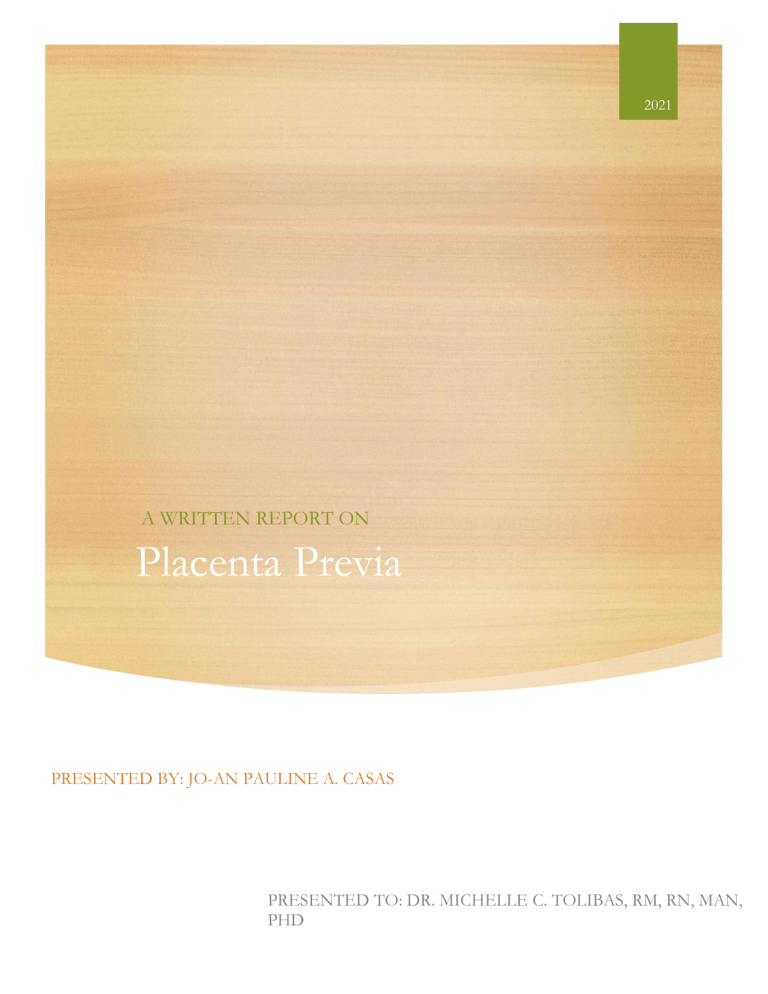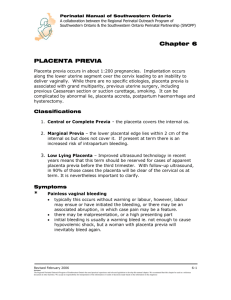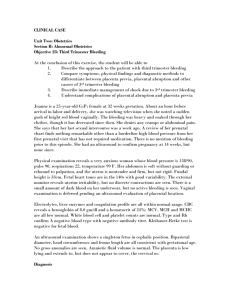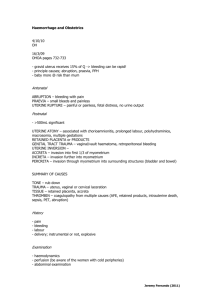
2021 A WRITTEN REPORT ON Placenta Previa PRESENTED BY: JO-AN PAULINE A. CASAS PRESENTED TO: DR. MICHELLE C. TOLIBAS, RM, RN, MAN, PHD Placenta Previa A condition of pregnancy in which the placenta is implanted abnormally in the lower part of the uterus, is the most common cause of painless bleeding in the third trimester of pregnancy (Mastrolia, Baumfeld, Loverro, et al., 2016). Placenta previa is the most common cause of painless bleeding in the later stages of pregnancy (after the 20th week). The placenta is a temporary organ that joins the mother and fetus and transfers oxygen and nutrients from the mother to the fetus. The placenta is disk-shaped and at full term measures about seven inches in diameter. The placenta attaches to the wall of the uterus (womb). Placenta previa is a complication that results from the placenta implanting either near to, or overlying, the outlet of the uterus (the opening of the uterus, the cervix). Because the placenta is rich in blood vessels, if it is implanted near the outlet of the uterus, bleeding can occur when the cervix dilates or stretches (Stöppler, 2020). Objectives After this report, you will be able to acquire knowledge in depth regarding definition, etiology, clinical features, diagnosis, complications, medical management of placenta Previa. Specifically, you will be able to: Define placenta Previa and Explain the etiological factors of Placenta Previa. Describe the types and classifications of Placenta Previa Describe the clinical symptoms & diagnosis of Placenta Previa. Describe the risk factors and predisposing factors that may lead to Placenta Previa List down the complications, effects and dangers of Placenta Previa to the mother and fetus Describe the signs and symptoms that may manifest with the condition of Placenta Previa Describe the management of Placenta Previa List the therapeutic and nursing management that address the needs of a woman experiencing a complication of Placenta Previa. Formulate nursing care plan care specific to a woman who has developed a Placenta Previa Key Terms Amniotic fluid- the clear liquid that surrounds a developing fetus in the mother's womb Blastocyst- term for the conceptus at the developmental stage that consists of about 100 cells shaped into an inner cell mass that is fated to become the embryo and an outer trophoblast that is fated to become the associated fetal membranes and placenta Bradycardia- is a slower than normal heart rate. The hearts of adults at rest usually beat between 60 and 100 times a minute. Cervical Os- the internal opening of the cervix Cesarean section- a surgical procedure involving incision of the walls of the abdomen and uterus for delivery of offspring. Contractions- tightening of the uterine muscles that help move the baby from the uterus to and through the birth canal Embryo- developing human during weeks Fetus- developing human during the time from the end of the embryonic period (week 9) to birth Gestation- in human development, the period required for embryonic and fetal development in utero; pregnancy Human Chorionic Gonadotropin (hCG)- hormone that directs the corpus luteum to survive, enlarge, and continue producing progesterone and estrogen to suppress menses and secure an environment suitable for the developing embryo Hemorrhage- a profuse discharge of blood, as from a ruptured blood vessel; bleeding. Implantation- process by which a blastocyst embeds itself in the uterine endometrium Labor- the process of childbirth, especially the period from the start of uterine contractions to delivery. Perineum- the area between the anus and the scrotum in the male and between the anus and the vulva (the labial opening to the vagina) Placenta- organ that forms during pregnancy to nourish the developing fetus; also regulates waste and gas exchange between mother and fetus Placenta Previa- low placement of fetus within uterus causes placenta to partially or completely cover the opening of the cervix as it grows Placentation- formation of the placenta; complete by weeks 14–16 of pregnancy Postpartum- time after childbirth Tachycardia- a heart rate that's too fast that the normal heart rate. Trophoblast- fluid-filled shell of squamous cells destined to become the chorionic villi, placenta, and associated fetal membranes Uterus- Part of the female reproductive system. It is a muscular organ where the embryo implants and grows during pregnancy. Types/Classification Low Lying – The placenta implants in the lower uterine segment but does not reach the cervical os; often this type of placenta previa moves upward as the pregnancy progresses, eliminating bleeding complications later. Marginal– The edge of the placenta is at the edge of the internal os; the mother may be able to deliver vaginally. Partial– The placenta partially covers the cervical os; as the pregnancy progresses and the cervix begins to efface and dilate, the bleeding occurs. Total– The placenta covers the entire cervical os; usually requires an emergency cesarean section. Incidence Placenta previa is found in approximately four out of every 1000 pregnancies beyond the 20th week of gestation. Asian women are at a slightly greater risk for placenta previa than are women of other ethnic groups, although the reason for this is unclear. It has also been observed that women carrying male fetuses are at slightly greater risk for placenta previa than are women carrying female fetuses. The risk of having placenta previa increases with increasing maternal age and with the number of previous deliveries. Women who have had placenta previa in one pregnancy also have a greater risk for having placenta previa in subsequent pregnancies. Causes Low implantation of placenta possibly because of uterine abnormality Researchers don't know what causes placenta previa. It is more likely to happen with certain conditions. These include: Past pregnancies Tumors (fibroids) in the uterus. These are not cancer. Past uterine surgeries or cesarean deliveries Woman who is older than 35 Woman who is African American or of another nonwhite ethnic background Cigarette smoking Placenta previa in a past pregnancy Being pregnant with a boy Risk factors, predisposing factors Placenta previa is more common among women who: Have had a baby Have scars on the uterus, such as from previous surgery, including cesarean deliveries, uterine fibroid removal, and dilation and curettage Had placenta previa with a previous pregnancy Are carrying more than one fetus Are age 35 or older Are of a race other than white Smoke Use cocaine Diagnosis: Laboratory, diagnostic examinations General examination: •The general condition of the patient depends upon the amount of blood loss. •Shock develops if there is acute severe blood loss and anemia develops if there is recurrent slight blood loss. Abdominal examination: • The uterus is corresponding to the GA, relaxed and not tender. • The fetal parts and heart sound (FHS) can be easily detected. • Malpresentation, particularly transverse and oblique lie and breech presentation are more common as well as non-engagement of the head. This is because the lower uterine segment is occupied by the placenta. Ultrasound • It is the simplest, precise and safe method for placental localization. A partially full bladder is necessary to identify the lower edge of the placenta. If it is less than 3 cm from the margin of the internal os, it is diagnosed as placenta Previa. • The posterior placenta Previa is difficult to be identified due to shadowing from the presenting part of the fetus. This can be overcome by head-down tilt of the patient or displacing, the presenting part manually. If difficulty still present, the distance between the presenting part and the promontory of the sacrum is measured. If this exceeds 1.5 cm it means that placenta lies in between. In mid - pregnancy the placenta reaches the internal os in up to 20% of pregnancies. With increasing gestational age and the formation of the lower uterine segment, a gap develops between the placental edge and the internal os "placental migration". So it is recommended to repeat scan when placenta Previa is diagnosed in mid - pregnancy. Don’t allow a vaginal examination to minimize placental trauma. Vaginal examinations should not be done in the presence of fresh bleeding because fresh bleeding may indicate that a placenta previa (implantation of the placenta so low in the uterus that it is encroaching on the cervical os) is present. Performing a vaginal examination in this instance might tear the placenta and cause hemorrhage, resulting in danger to both the mother and fetus. Make certain a primary care provider knows about the fresh bleeding before attempting a vaginal examination. Prognosis The majority of women with placenta previa in developed countries will deliver healthy babies, and the maternal mortality (death) rate is less than 1%. In developing countries where medical resources may be lacking, the risks for mother and fetus may be higher. Complications/Effects/Danger (mother and fetus) Placenta previa can be associated with other abnormalities of the placenta or of the umbilical cord. Some studies have shown a reduction in fetal growth associated with placenta previa, and the presence of the placenta in the lower part of the uterus makes breech or abnormal presentation of the fetus more likely. The bleeding of placenta previa can increase the risk for preterm premature rupture of the membranes (PPROM), leading to premature labor. Placenta accreta is a serious complication that occurs in 5% to 10% of women with placenta previa. Placenta accreta results when the placental tissue grows too deeply into the womb, attaching to the muscle layer, resulting in difficulty separating the placenta from the wall of the uterus at delivery. This complication can cause life-threatening bleeding and commonly requires hysterectomy at the time of Cesarean delivery. As with other complications of pregnancy, placenta previa can have a significant emotional impact on the pregnant woman. Vaginal bleeding secondary to placenta previa can lead to postpartum hemorrhage requiring a blood transfusion, hysterectomy, maternal intensive care admission, septicemia, and maternal death. Postpartum hemorrhage is blood loss greater than or equal to 1000 ml accompanied by signs or symptoms of hypovolemia occurring within 24 hours after delivery, regardless of the route of delivery. This condition may necessitate blood transfusion, uterotonics, uterine artery embolization, iliac artery ligation, balloon tamponade, and hysterectomy. Placenta previa that is not diagnosed early enough or managed improperly can lead to morbidity and mortality for both the mother and fetus. Placenta previa is also associated with preterm birth, low birth weight, lower APGAR scores, longer duration of hospitalization, and higher blood transfusion rates.[1] Women with placenta previa and prior history of cesarean sections are at an increased risk of PAS. Risk of placenta accreta is 3%, 11%, 40%, 61%, and 67%, for the first, second, third, fourth, and fifth or more cesarean, respective Assessment (signs and symptoms) The bleeding with Placenta Previa doesn’t usually begin, however, until the lower uterine segment starts to differentiate from the upper segment late in pregnancy (approximately week 30) and the cervix begins to dilate. At that point, because the placenta is unable to stretch to accommodate the differing shape of the lower uterine segment or the cervix, a small portion loosens and damaged blood vessels begin to bleed. The bleeding is usually abrupt, painless, bright red, and sudden enough to frighten a woman. It is not associated with increased activity or participation in sports and may stop as abruptly as it began, so that by the time a woman is seen at the healthcare setting, she is no longer bleeding. In other women, it may slow after the initial hemorrhage but linger as continuous spotting. (Faan & Pnp, 2017, pp. 538). According to Gaiman (2019), bleeding is the primary symptom of placenta previa and occurs in the majority (70%-80%) of women with this condition. Vaginal bleeding after the 20th week of gestation is characteristic of placenta previa. The placenta in this stage is well developed or matured and needed more blood supply, so it migrates to a more vascularized part of the uterus. Bleeding, bright red in color is associated with the stretching and thinning of the lower uterine segment that occurs during the third trimester. Usually the bleeding is painless, but it can be associated with uterine contractions and abdominal pain. The uterus is not able to adequately contract and stop blood flow from open vessels. Bleeding may range in severity from light to severe. Nursing diagnosis Fear related to outcome of pregnancy after episode of placenta previa bleeding Fear related to Threat to Maternal and Fetal Survival Secondary to Excessive Blood Loss Deficient Fluid Volume r/t Active Blood Loss Secondary to Disrupted Placental Implantation Decreased cardiac output r/t altered contractility Ineffective tissue perfusion r/t decreased HgB concentration in blood & hypovolemia Risk for Impaired Fetal Gas Exchange r/t Disruption of Placental Implantation Active Blood Loss (Hemorrhage) r/t Disrupted Placental Implantation Activity Intolerance r/t Enforced Bed Rest During Pregnancy Secondary to Potential for Hemorrhage Altered Diversional Activity r/t Inability to Engage in Usual Activities Secondary to Enforced Bed Rest and Inactivity During Pregnancy Discussion Age is a risk factor. Age is associated with a varying incidence of Placenta Previa. The risk of Placenta Previa is increased with increasing maternal age. Placenta Previa in turn increases the risk of complications like obstetrical hemorrhage and the need for caesarean hysterectomy. Placenta Previa is associated with male births. The reason for this is not known but it could be linked to maternal hormones or prematurity. Premature rupture of membranes occurs more commonly in pregnant women with male babies and Placenta Previa is also more common in premature pregnancies. (Kiondo et al., 2008) The contributing factors for Placenta Previa is a previous delivery by caesarean section. The risk increases with the number of caesarean sections performed. The incidence is 2% after one previous caesarean section, 4.1% after two and 22% after three. Similarly, dilation and curettage, evacuation of uterus and myomectomy are associated with Placenta Previa and is more common in older and multiparous women; the reason is not clear but it may be associated with the ageing of vasculature of the uterus. This causes placental hypertrophy and enlargement which increases the likelihood of the placenta encroaching on lower segment. Birth spacing is also associated with a risk of Placenta Previa. In a study carried out among Norwegian women, it was found that birth spacing of more than four years was associated with Placenta Previa, this could be due to scarring or poor vasculature of the uterus which is associated with increasing age. Mothers with Placenta Previa have a ten-fold risk of reoccurrence in a subsequent pregnancy. This is thought to be linked to defective decidual vascularisation. Moreover, abnormal placentation and smoking have been attributed to abruptio placenta and Placenta Previa. Smoking seems to increase the risk of previa via a hypoxemia-related mechanism. Nicotine has a vasoconstricting effect on uteroplacental perfusion in smoking mothers. Placental studies have demonstrated decreased vascularization and pronounced changes in the broad basement membrane of mothers who smoked cigarettes. Multiple pregnancies are also associated with Placenta Previa, this is because the large placenta usually encroaches on lower segment of the uterus (Kiondo et al., 2008). The underlying cause of placenta previa is unknown. There is, however, an association between endometrial damage and uterine scarring. The implantation of a zygote (fertilized egg) requires an environment rich in oxygen and collagen. The outer layer of the dividing zygote, blastocyst, is made up of trophoblast cells which develops into the placenta and fetal membranes. The trophoblast adheres to the decidua basalis of the endometrium, forming a normal pregnancy. Prior uterine scars provide an environment that is rich in oxygen and collagen. The trophoblast can adhere to the uterine scar leading to the placenta covering the cervical os or the placenta invading the walls of the myometrium. There normally exists an apparent placental migration, with one edge of the placenta growing while the opposite edge atrophies. It has been noted that the placenta initially will occupy from one half to one third of the uterine wall. By term, however, no more than one fourth to one sixth of the uterine surface is covered. This change in ratio permits a degree of apparent placental movement. In placenta previa, it is postulated that there is an impairment of this normal placental progression away from the cervical os. It is believed that this migration is impaired in women with surgically scarred uteri, which is why they are at greater risk for placenta previa. It occurs in four degrees: implantation in the lower rather than in the upper portion of the uterus (low-lying placenta), marginal implantation (the placenta edge approaches that of the cervical os), implantation that occludes a portion of the cervical os (partial Placenta Previa), and implantation that totally obstructs the cervical os (total Placenta Previa). The degree to which the placenta covers the internal cervical os is generally estimated in percentages: 100%, 75%, 30%, and so forth (Faan & Pnp, 2017, pp. 538). Towards the end of the pregnancy, the wall of the uterus at the cervix thins out to widen the passage for the baby. Normally this is a good thing, but in placenta previa, it can be a pretty dangerous thing. When wall of the uterus thins out, the attachment between the uterus and the placenta is actually strained. It starts to become weakened and the placenta starts to detach. The uterine arteries which are in the wall of the uterus are being tugged on in one direction as the wall thins out, but since they're also attached to the placenta, they're also being tugged on in the opposite direction. The tension on these arteries can cause them to rupture and blood leaks through into the vagina. Bleeding is the primary symptom of Placenta Previa and occurs in the majority (70%-80%) of women with this condition. Vaginal bleeding after the 20th week of gestation is characteristic of Placenta Previa. The placenta in this stage is well developed or matured and needed more blood supply, so it migrates to a more vascularized part of the uterus. Bleeding, bright red in color is associated with the stretching and thinning of the lower uterine segment that occurs during the third trimester. Usually the bleeding is painless, but it can be associated with uterine contractions and abdominal pain. The uterus is not able to adequately contract and stop blood flow from open vessels. (Gaiman, 2019) The most common cause of fetal distress is when the baby doesn't receive enough oxygen because of problems with the placenta (including placental abruption or placental insufficiency) Placental insufficiency occurs when the placenta does not develop properly, or is damaged. This blood flow disorder is marked by a reduction in the mother’s blood supply. The complication can also occur when the mother’s blood supply doesn’t adequately increase by mid-pregnancy. When the placenta malfunctions, it’s unable to supply adequate oxygen and nutrients to the baby from the mother’s bloodstream. Without this vital support, the baby cannot grow and thrive. This can lead to low birth weight, premature birth, and birth defects. Low birth weight is defined as a birth weight of an infant less than 2500 grams at full term. It can result from intrauterine growth restriction and/or preterm birth. IUGR is often a comorbidity of preterm birth and it is linked with induction of assisted and non-assisted premature delivery. Moreover, excessive maternal hemorrhage can cause a severe drop in blood pressure. It may lead to shock and death if not treated. Pathophysiologic events/pathophysiology (Discussion and Schematic diagram) Risk Factors • Woman who is older than 35 • Woman who is African American or of another nonwhite ethnic background Cause The underlying cause of Placenta Previa is unknown. There is, however, an association between endometrial damage and uterine scarring. Contributing factors • Have scars on the uterus, such as from previous surgery, including cesarean deliveries, uterine fibroid removal, and dilation and curettage • Genetics • Being pregnant with a boy • Are of a race other than white • Are carrying more than one fetus • Past pregnancies • Birth spacing • Had placenta previa with a previous pregnancy • Smoke • Use cocaine Prior uterine scars provide an environment that is rich in oxygen and collagen Placenta migrates to where there is sufficient blood supply An impairment in the normal placental progression away from the cervical os. Placenta resides in the lower uterine segment Total Placenta Previa THE PLACENTA COVERS THE ENTIRE CERVICAL OS Partial Placenta Previa Marginal Placenta Previa THE PLACENTA PARTIALLY COVERS THE CERVICAL OS THE EDGE OF THE PLACENTA IS AT THE EDGE OF THE INTERNAL OS Low-lying Placenta Previa THE PLACENTA IMPLANTS IN THE LOWER UTERINE SEGMENT BUT DOES NOT REACH THE CERVICAL OS When the stretching and thinning of the lower uterine segment occurs in third trimester, the attachment between the uterus and the placenta is strained and the placenta starts to detach As the wall thins out, the uterine arteries in the wall of the uterus are being tugged on in one direction, since they're also attached to the placenta, they're also being tugged on in the opposite direction. Tension on these arteries can cause them to rupture Bright Red Painless Vaginal Bleeding Excessive maternal hemorrhage Low maternal blood flow Placental insufficiency Intrauterine Growth Retardation Severe drop in blood pressure Lack of oxygen Shock Fetal distress Death Preterm birth Birth defects Low birth weight Therapeutic Management For a first (sentinel) episode of vaginal bleeding before 36 weeks, management consists of: Hospitalization Modified activity (modified rest)- involves refraining from any activity that increases intraabdominal pressure for a long period of time—eg, women should stay off their feet most of the day.) Avoidance of sexual intercourse, which can cause bleeding by initiating contractions or causing direct trauma. If bleeding stops, ambulation and usually hospital discharge are allowed. Typically for a 2nd bleeding episode, patients are readmitted and may be kept for observation until delivery. Some experts recommend giving corticosteroids to accelerate fetal lung maturity when early delivery may become necessary and gestational age is < 34 weeks. Corticosteroids may be used if bleeding occurs after 34 weeks and before 36 weeks (late preterm period) in patients who have not required corticosteroids before 34 weeks (1). Timing of delivery depends on the maternal and/or fetal condition. If the patient is stable, delivery can be done at 36 weeks/0 days to 37 weeks/6 days. Documentation of lung maturity is no longer necessary. Delivery is indicated for any of the following: - Heavy or uncontrolled bleeding - Nonreasoning results of fetal heart monitoring - Maternal hemodynamic instability Delivery is cesarean for placenta previa. Vaginal delivery may be possible for women with a low-lying placenta if the placental edge is within 1.5 to 2.0 cm of the cervical os and the clinician is comfortable with this method. Hemorrhagic shock is treated. Prophylactic Rho(D) immune globulin should be given if the mother has Rh-negative blood. Nursing Management Inspect the perineum for bleeding and estimate the present rate of blood loss. Weighing perineal pads before and after use and calculating the difference by subtraction is a good method to determine vaginal blood loss. An Apt or Kleihauer– Betke test (test strip procedures) can be used to detect whether the blood is of fetal or maternal origin. Obtain baseline vital signs to determine whether symptoms of hypovolemic shock are present. Continue to assess blood pressure every 5 to 15 minutes or continuously with an electronic cuff. Never attempt a pelvic or rectal examination with painless bleeding late in pregnancy because any agitation of the cervix when there is a placenta previa might tear the placenta further and initiate massive hemorrhage, possibly fatal to both mother and child. Attach external monitoring equipment to record fetal heart sounds and uterine contractions (an internal monitor for either fetal or uterine assessment is contraindicated). Hemoglobin, hematocrit, prothrombin time, partial thromboplastin time, fibrinogen, platelet count, type and cross-match, and antibody screen will be assessed to establish baselines, detect a possible clotting disorder, and ready blood for replacement if necessary. Monitor urine output frequently, as often as every hour, as an indicator her blood volume is remaining adequate to perfuse her kidneys. Administer intravenous fluid as prescribed, preferably with a large-gauge catheter to allow for blood replacement through the same line. A vaginal birth is always safest for an infant. It is essential, therefore, to determine the placenta’s location as accurately as possible in the hope that its position will make vaginal birth feasible. If the previa is under 30% by abdominal or intravaginal ultrasound, it may be possible for the fetus to be born past it. If over 30%, and the fetus is mature, the safest birth method for both mother and baby is often a cesarean birth (Kim, Joung, Lee, et al., 2015). If only a minimum previa is detected by sonogram, the primary healthcare provider may attempt a careful speculum examination of the vagina and cervix to establish the degree of fetal engagement and to rule out another cause for bleeding, such as ruptured varices or cervical trauma. This should be done in an operating room or a fully equipped birthing room so that if hemorrhage does occur with cervical manipulation, an immediate cesarean birth can be carried out to remove the child and the bleeding placenta and contract the uterus. Have oxygen equipment available in case the fetal heart sounds indicate fetal distress, such as bradycardia or tachycardia, late deceleration, or variable decelerations during the exam. NCP Care Plan No.: ___1___ Patient’s Name: _____P.T. Assessment Cues Age/Sex: _36/Female_______ Chief Complaint/s: Severe bleeding Nursing Diagnosis Subjective: “Dinudugo ako at tila marami nang lumalabas na dugo sa akin!” (I’m bleeding and it seems like there’s a lot of blood coming out from me) as verbalized by the patient. Objective: -Bleeding episodes -Manifest body weakness -Low BP of 90/50 mm Hg -Increased HR of 100 beats per minute Outcome Identification Goal: Fluid volume Deficient r/t Active Blood Blood Loss Secondary to Disrupted Placental Implantation Scientific Basis: Fluid volume deficient is a state in which an individual is experiencing decreased intravascular, interstitial and/or intracellular fluid. Active Blood Loss or hemorrhage due to disrupted placental implantation during pregnancy may manifest signs and symptoms of fluid volume deficient that After rendering nursing intervention and medical assistance, patient will exhibit signs of adequate fluid balance during pregnancy Planned Nursing Interventions Nursing Rationale Interventions Independent: -Assess color, odor, consistency and amount of vaginal bleeding; weigh pads -Assess hourly intake and output Desired Outcome: The patient will be able to: -Maintain fluid volume at a functional level as evidenced by individually adequate urinary output with -Assess baseline data and note changes. Monitor FHR -Provides information about active bleeding versus old blood, tissue loss and degree of blood loss -Provides information about maternal and fetal physiologic compensation to blood loss -Assessment provides information about possible infection, placenta previa or abruption. Warm, moist, bloody environment is ideal for growth of microorganisms. Evaluation Goal met. After rendering nursing intervention and medical assistance, the patient has exhibit signs of adequate fluid balance. The patient has maintained fluid volume at a functional level as evidenced by individually adequate urinary output with normal specific gravity, stable vital signs, moist mucous membranes, good Skin turgor, prompt capillary refill. -Decreased RR of 12 breaths per minute may later lead to hypovolemic shock and cause maternal and fetal death. -Fetal heart rate >120-160 bpm Reference: -Decreased urine output -Increased urine concentration -Pale, cool skin Vera, M. B. (2019b, June 1). 3 Placenta Previa Nursing Care Plans. Nurseslabs. https://nurseslabs. com/3- placentaprevia-nursing-careplans /#decreased _cardiac_output normal specific gravity, stable vital signs, moist mucous membranes, good Skin turgor, prompt capillary refill. -Assess abdomen for tenderness or rigidity-if present, measure abdomen at umbilicus (specify time interval) -Detecting increased in measurement of abdominal girth suggest active abruption -Assess SaO2, skin color, temperature, moisture, turgor, capillary refill (specify frequency) -Assessment provides information about blood volume, O2 saturation and peripheral perfusion -Assess for changes in LOC: note for complaints of thirst or apprehension -To detect signs of cerebral perfusion -Monitor laboratory work as obtained: Hgb & Hct, Rh and type, cross match for 2 units RBC’s, urinalysis, etc. Scheduled for ultrasound as ordered. -Laboratory work provides information about degree of blood loss; prepares for possible transfusion. Ultrasound provides info about the cause of bleeding. -Provide emotional support; keep patient and family informed of findings and continuing plan of care. -Support and information decreases anxiety and help patient and family to anticipate what might happen next. Dependent: -Provide supplemental O2 as ordered via facemask or nasal cannula @ 10-12 L/min. -Intervention increases available O2 to saturate decreased hemoglobin -Initiate IV fluids as ordered (specify fluid type and rate). -For replacement of fluid volume loss -Position patient in supine with hips elevated if ordered or left lateral position. -Position decreases pressure on placenta and cervical os. Left lateral position improves placental perfusion. -Determine if patient has any objections to blood transfusions—inform physician. -Administer blood transfusion as ordered with client consent -Monitor closely for transfusions reaction Patient may have religious beliefs related to accepting blood products. -To provide replacement of blood components and volume -To prevent for potentially lifethreatening allergic reaction that may result from incompatible blood Collaborative: -Administer prenatal vitamins and iron as ordered: provide a diet high in iron; lean meats, dark green leafy vegetables, eggs, and whole grains. Prepare patient for cesarean birth if ordered when severe hemorrhage, abruption, complete previa at term is already experienced. -Proper diet and vitamins replace nutrient lost from active bleeding to prevent anemiairon is a necessary component of hemoglobin -Cesarean birth may be necessary to resolve the hemorrhage or prevent fetal or maternal injury. Care Plan No.: ___2___ Patient’s Name: _____P.T. Assessment Cues Age/Sex: _36/Female_______ Chief Complaint/s: Difficulty breathing and nausea Nursing Diagnosis Subjective: “Maglisod kog ginhawa unya malipong sad” as verbalized by the patienyt Objective: -Dysrhythmias -Prolonged capillary refill -Cold clammy skin Goal: Nursing Diagnosis: Decreased cardiac output related to altered cardiac contractility secondary to placenta previa, as evidenced by cardiac dysrhythmias, cold and clammy skin, shortness of breath, variations in blood pressure readings, and restlessness -Dyspnea Scientific Basis: -Restlessness -Variations in BP reading Outcome Identification Placenta previa is the development of placenta in the lower uterine segment partially or completely covering the internal cervical os. Placenta Previa After 4 hrs of Nursing Intervention, the patient will participate and demonstrate activities that reduce the workload of the heart. Desired Outcome: Patient will manifest hemodynamic stability. Planned Nursing Interventions Nursing Rationale Interventions Independent: -Establish Rapport -To gain patient’s trust -Monitor Vital Signs -To obtain baseline data -History taking -To determine contributing factors -Assess patient condition -To assess contributing factors -Review lab data -For comparison with current normal values -Monitor BP & Pulse frequently -To note response to activity -Provide information on test procedures -To gain patient’s participation -Provide adequate rest & Reposition client -To promote venous return Evaluation Goal met. After 4 hrs of Nursing Intervention, the patient was able to participate and demonstrate activities that reduce the workload of the heart. The patient has manifested hemodynamic stability. causes bleeding. Due to large amounts of blood lost, the heart tries to pump faster in order to compensate for blood loss. As a result, the heart pumps faster with lesser blood pumped. Reference: Vera, M. B. (2019b, June 1). 3 Placenta Previa Nursing Care Plans. Nurseslabs. https://nurseslabs. com/3- placentaprevia-nursing-careplans /#decreased _cardiac_output -Encourage relaxation techniques -To alleviate stress & anxiety Care Plan No.: ___3___ Patient’s Name: _____P.T. Assessment Cues Age/Sex: _36/Female_______ Chief Complaint/s: Nausea and body weakness Nursing Diagnosis Subjective: “Usahay malipong unya maluya akong lawas” as verbalized by the patient. Goal: Ineffective tissue perfusion r/t decreased HgB concentration in blood & hypovolemia Objective: Restlessness Confusion Irritability Manifest Body Weakness Capillary refill more than 3 sec Oliguria Outcome Identification Planned Nursing Interventions Nursing Rationale Interventions Independent: Patient will demonstrate behaviors to improve circulation. -Establish Rapport -To gain patient’s trust -Monitor Vital Signs -To obtain baseline data Desired Outcome: -Assess patient condition -To assess contributing factors Scientific Basis: Placenta Previa causes painless and continuous bleeding. With bleeding, there is decreased Hemoglobin. Hemoglobin carries oxygen to different parts of the body. If there is decreased hemoglobin there is a failure to nourish the tissues at the capillary level. Reference: Patient will demonstrate increased perfusion as individually appropriate. (e.g. hematocrit, hemoglobin, RBC,WBC, capillary refill, BP within normal range, absence of edema). -Note customary baseline data (usual BP, weight, lab values) -Determine presence of dysrhythmias -Perform blanch test -Check for Homan’s Sign -For comparison with current findings -To identify alterations from normal -To identify and determine adequate perfusion Evaluation Goal partially met. .After 2 days of nursing intervention, the client was able to demonstrate light increased perfusion as evidenced by increased in hemoglobin (79.0g/L),hematocrit (.22),RBC(2.28 10^12/L)and WBC (2.9010^9/L) but still with the presence of pallor, edema, delayed capillary refill. Vera, M. B. (2019b, June 1). 3 Placenta Previa Nursing Care Plans. Nurseslabs. https://nurseslabs. com/3- placentaprevia-nursing-careplans /#decreased _cardiac_output -To determine presence of thrombus formation -Encourage quiet & restful environment -Elevate HOB -Encourage use of relaxation techniques -To lessen O2 demand -To promote circulation -To decrease tension level References Anderson-Bagga, F. M. (2020, June 27). Placenta Previa - StatPearls - NCBI Bookshelf. National Center for Biotechnology Information, U.S. National Library of Medicine. https://www.ncbi.nlm.nih.gov/books/NBK539818/ Betts, G. J. (2013, March 6). Embryonic Development – Anatomy and Physiology. Pressbooks. https://opentextbc.ca/anatomyandphysiologyopenstax/chapter/embryonic-development/ Faan, S. J. D. C. I., & Pnp, P. A. P. R. (2017). Maternal and Child Health Nursing: Care of the Childbearing and Childrearing Family (8th ed., Vol. 1). LWW. Gaiman, N. (2019, October 9). CP Placenta Previa. Scribd. https://www.scribd.com/doc/20845207/CP-Placenta-Previa Kiondo, P., Wandabwa, J., & Doyle, P. (2008, March 1). Risk factors for placenta praevia presenting with severe vaginal bleeding in Mulago hospital, Kampala, Uganda. PubMed Central (PMC). https://www.ncbi.nlm.nih.gov/pmc/articles/PMC2408550/ Mayo Foundation for Medical Education and Research. (2020, May 30). Placenta previa Symptoms and causes. Mayo Clinic. https://www.mayoclinic.org/diseases- conditions/placenta-previa/symptoms-causes/syc-20352768 R. (2020, August 21). Placenta Previa Nursing Management. Nursing Journal | RNspeak. https://rnspeak.com/placenta-previa-nursing-management/ Stöppler, M. C. (2020, January 7). Placenta Previa Symptoms, 3 Types, Causes, Risks, Treatment. MedicineNet. https://www.medicinenet.com/pregnancy_placenta_previa/article.htm Vera, M. B. (2019, June 1). 3 Placenta Previa Nursing Care Plans. Nurseslabs. https://nurseslabs.com/3-placenta-previa-nursing-care-plans/




